Andrew Paul Wood – 23 November, 2011
In an image-saturated world which demands signs be easily and quickly digestible, Rae is an oddity. Her paintings force us to slow down and take a meditative approach. That she chooses to work in a strictly representational way is also striking in the context of contemporary art.
“Until I saw Chardin’s painting,” wrote Marcel Proust, “I never realized how much beauty lay around me in my parents’ house, in the half-cleared table, in the corner of a tablecloth left awry, in the knife beside the empty oyster shell.” I feel much the same about Jude Rae’s still life paintings, which owe more than a little to Jean-Baptiste-Simeon Chardin’s tactile qualities and projected sense of physicality and object-ness. We are never once under the impression that these things do not actually exist somewhere in the world. Rae’s fire extinguishers smoulder ember-like with warmth like Chardin’s famous strawberries in Basket of Wild Strawberries (1761) in a similar chromatically desaturated setting. There is also something of Giorgio Morandi’s metaphysical still lifes in Rae’s tight compositions and endless leitmotif-like rearrangements of familiar and recognisable objects.
As with Morandi, humble items form a kind of tabletop landscape echoing De Chirico’s Pittura Metaphysica on a modest, domestic scale. In an image-saturated world which demands signs be easily and quickly digestible, Rae is an oddity. Her paintings force us to slow down and take a meditative approach. That she chooses to work in a strictly representational way is also striking in the context of contemporary art. I do not wish to sound patronising, but as with pre-contact Amazonian tribes and black rhinoceroses, it draws fans and makes them protective. It is accessible in a way that much contemporary art is not, but neither is it shallow, kitsch, or cliché. It both deserves respect, and is good (technically and poetically).
Rae’s New Paintings at the Jonathan Smart Gallery showcased her mastery of the genre, bringing it into the twenty-first century with water cooler bottles and other plastic paraphernalia, and some ceramics that would not be out of place in the kitchen of Mrs Rubens or Mrs Rembrandt. It also presented some intriguing departures; the painting SL#286, for example, reveals Rae trying to break up the cool perfection of her painterly surface with solvent dribbles. It’s as if she was trying to dissolve the fourth wall with turpentine. The effect will have to be more pronounced, however, if this alkahest is going to have a meaningful result on the viewer. It needs to literally break into something sculptural and enter the gallery space, or corrosively eat into the canvass to have any impact - otherwise it just seems a bit twee and noncommittal. This particular Rubicon has not yet been crossed.
The painting Interior 278 (Munich 1) is a completely new direction for Rae. It depicts the partitions and reflective surfaces of an airport departure lounge, curiously flattened into an interplay between grid and illusory perspectival space. Although it at first reminds me of Richard Estes’ photographically hyperrealist urban scenes rendered to an almost abstract aggregation of tour de force surface textures. Rae, however is more impressionistic than that (though not as impressionistic as her still lifes, admittedly), perhaps closer to Brian Alfred, Eberhard Havekost, and Carla Klein. I had a sense of déjà vu that I could not place until the label confirmed I had been there myself. Grüß Gott! I was once more waiting for my connecting flight from Heathrow to Hong Kong on my way back to New Zealand.
This is good old-fashioned painting, and Rae shows that it’s still got many kilometres worth of gas left in the tank. This work clearly shows an artist in transition and it will be particularly interesting to see where she shifts to on this connecting flight in her career.
Andrew Paul Wood
Recent Comments
Jude Rae
Andrew, my apologies for getting your name wrong. The fallible ball of jelly is rarely the problem. It's usually the ...
John Hurrell
Because I'm interested in both image and material subtleties, Jude, I'd say the Victoria Chambers works (charcoal and matt) have ...
Andrew Paul Wood
Ouch. I suppose that comment about "evolving" was open to misinterpretation - I really meant that artists who continually evolve ...
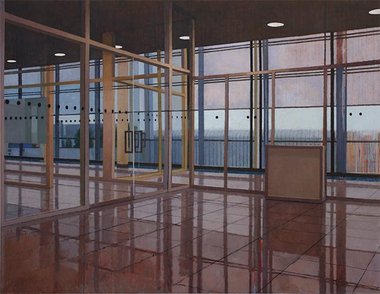
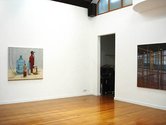
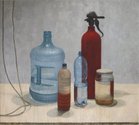
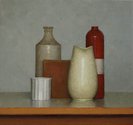
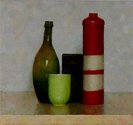
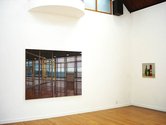
 Advertising in this column
Advertising in this column Two Rooms presents a program of residencies and projects
Two Rooms presents a program of residencies and projects



This Discussion has 6 comments.
Comment
John Hurrell, 8:10 a.m. 23 November, 2011 #
Jude, with that Munich painting, seems to be moving into Paul Winstanley territory. For me it's a far more interesting area than the still lifes which she has flogged to death. That new spatial dimension gets away from the usual, very close, Morandi/Chardin depth and has an appealing complexity. It is to me less claustrophobic.
Andrew Paul Wood, 6:35 p.m. 23 November, 2011 #
John, I agree that it's an interesting new direction into something more expansive and spatially complex, but I am not ashamed of my fondness for the still life work. Regardless, I am glad Jude is evolving - artists should.
Jude Rae, 7:47 p.m. 23 November, 2011 #
Well thank you Paul and John, for the rather belated attention. The Christchurch show came down the day your review went up - well done boys. Nice to see that Christchurch hasn't entirely fallen off your critical map.
John, one man's "flogging to death" is probably another man's enduring exploration. As usual, you fail to understand the material subtleties of painting because you see visual art in terms of image (amply demonstrated in your Winstanley review).
As for your reference to a new spatial dimension in my work, architectural interiors have been a focus for me at least since 2004. Victoria Chambers came out of the 2006 Dunedin residency and airports have featured since 2008. So Munich is hardly a new development.
Paul, your writing shows a sensitivity which compensates for a certain inconsistency in observation. If you are going to indulge in cosy little onsite chats with Hurrell however, please try to avoid being patronising. Artists just hate that....
Andrew Paul Wood, 3:24 p.m. 24 November, 2011 #
Ouch. I suppose that comment about "evolving" was open to misinterpretation - I really meant that artists who continually evolve in their practice are far more interesting (to me, at least) than those who get stuck in stylistic cul-de-sacs because it is convenient to the market (and I certainly wasn't accusing you of that). It is marvelous when artists respond constructively, the critic is only human - and as for inconsistency, the eye is only a fallible ball of jelly.
Andrew
John Hurrell, 5:15 p.m. 24 November, 2011 #
Because I'm interested in both image and material subtleties, Jude, I'd say the Victoria Chambers works (charcoal and matt) have a different sort of depth and feel than say Munich (with its oil paint, reflected light and linear complexity.) As you say, you've been doing both for a while, and while some of the bottles and jars have reflection too, the architectural works do show an unusual (for you) interest in fragmentation and division of the spatial field. They represent a different sort of contemplative activity than studying lines of objects on a shelf or table.
Jude Rae, 2:16 p.m. 25 November, 2011 #
Andrew, my apologies for getting your name wrong. The fallible ball of jelly is rarely the problem. It's usually the grey matter behind that causes the problems.
John, nice to see you manifest an interest in terms of discussion more complex than "flogging to death"...
Participate
Register to Participate.
Sign in
Sign in to an existing account.